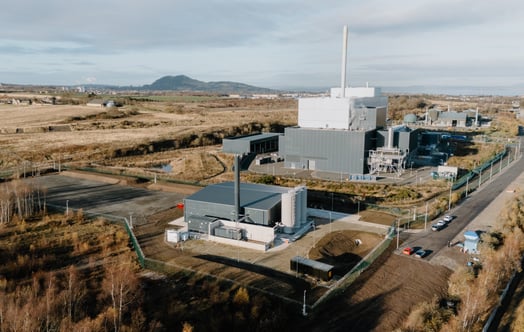
Despite the obvious benefits of heat networks delivering efficient, low carbon heat, they remain relatively unknown to developers and consumers, writes Amy Ritchie, External Affairs lead on Heat Networks, The Association for Decentralised Energy.
The decarbonisation of heat once took a back seat in the discussions on how we must adapt our energy system to meet net zero targets. However, this often thorny issue is now being considered with growing urgency, as recent figures on the sales of gas boilers show that the UK may be moving in the wrong direction. Step forward district heating.
First introduced in urban areas of the UK in the 1960s and 70s as a heating solution for flat blocks, it is estimated that heat networks will need to meet 18% of the UK’s heat demand by 2050 if we are to meet our climate targets. There is huge potential to both expand existing networks through retrofit, and install networks in new developments to deliver reliable, cost-effective heat to consumers. Many of the technologies that will deliver the shift to low carbon heating are already in place, with a growing number of successful case studies we can look to across the country.
If you are a developer considering which heating option is right for your development, or a local authority considering how to decarbonise your local area or your building stock, district heating could be right for you.
Heat networks are fit for a net zero energy system
Firstly, heat networks are fuel agnostic and installations can be adapted to local contexts. This means that installations will be able to deliver low carbon heat to consumers well into the future, even as the fuel mix changes and electrical sources such as wind and solar PV become more prevalent. Heat is an inherently local issue, and the ADE believes that a “zoned” approach to heat decarbonisation will be most effective. For example, urban areas may have access to waste heat that could be used in district heat networks, whereas rural, off-gas areas may be more reliant on electrification. Zones would be identified based on local assets and opportunities, which would be considered as part of local energy planning.
This would allow local authorities more autonomy to consider the best solution for their area and encourage greater collaboration between stakeholders. As heating solutions will differ by area, so will the skills and supply chains required to deliver them. Under an ideal framework, local authorities and companies would work together to identify and address any gaps, thus creating local jobs and growth that would ultimately benefit all stakeholders. The Heat Networks Industry Council estimates that the sector has the potential to deliver 35,000 new direct jobs, along with wider indirect growth as a result of investment in district heating.
For developers and local authorities making decisions about investments in low carbon heating now, without a clear strategy from the government for decarbonising the UK’s heating, heat networks offer a low regrets option. Installing heat networks is a futureproofed solution, as they are consistent with all net zero pathways.
Moreover, heat networks have the potential to intertwine with other low carbon energy solutions to unlock wider system benefits. Coupling with energy efficiency measures such as solid or cavity wall insulation can further lower energy bills and enable consumers to engage with smart technologies such as domestic DSR.
Heat networks offer a cost effective, reliable solution
Secondly, heat networks are a cost-effective way to decarbonise heating. On average, heat network customers pay £100 less than those on individual gas boilers. Well-designed schemes consider local contexts can deliver cost effective outcomes for both the developer/local authority, operator, and consumer. In many cases, cheap wasted heat from sources such as energy recovery facilities, data centres and heavy industry can be accessed. Some innovative cases have even seen heat harnessed from the London Underground. Not only is this significantly cheaper, it is also a lower carbon option than energy created directly for heating purposes. The government has also committed to supporting development of heat networks, which it has recently identified as a High Potential Opportunity – with £320m invested through the Heat Networks Investment Project and £270m through the forthcoming Green Heat Networks Fund, to support the delivery of networks. Local authorities can also access support for project development through the Heat Networks Delivery Unit.
In some cases, local authorities use planning policies to support deployment of heat networks, where they have already identified that a heat network would be an appropriate way to decarbonise heating in a local area.
Heat networks will improve the consumer offering of efficient, low carbon heat
Finally, and perhaps most importantly, district heating has the potential of a significantly improved offer to the consumer. Adapting our energy system to be fit for net zero will require some level of disruption to consumers, but heat networks are a low disruption, low regrets option. Because of their technology agnosticism, and because generation plant is not within consumers homes, houses are less likely to require internal retrofit at a later date, meaning less disruption for homes and businesses. Instead, when a generation asset reaches the end of its life, consumers need not take any action, as this process will be managed for them by the heat network owner or operator. This makes district heating an attractive option for developers and local authorities, as it is a hassle-free option for consumers once installed – no more waiting around for your boiler to be serviced! District heat networks can also be space saving; by centralising plant, there is no need for individual heating solutions within peoples’ homes, freeing up vital floor space and increasing property value.
Despite the obvious benefits of heat networks delivering efficient, low carbon heat, they remain relatively unknown to developers and consumers. Heat networks will be hugely important as we look to decarbonisation our energy system, and they have the potential to offer reliable, low carbon heat to millions of consumers across the country. While they may not be the best solution for every area, it is vital that district heating is given equal weighting when considering low carbon heating solutions for new and existing developments given the vast number of benefits they can unlock.



